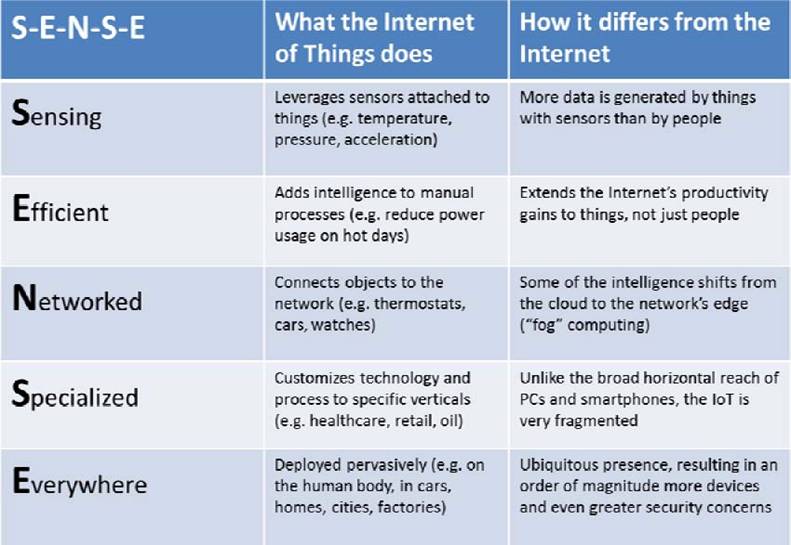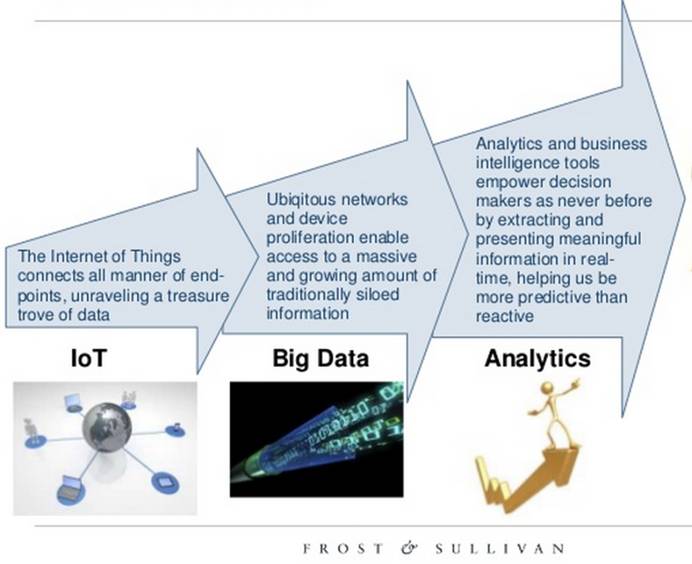The Internet of Things (IoT) is the network of physical objects accessed through the Internet. These objects contain embedded technology to interact with internal states or the external environment. In other words, when objects can sense and communicate, it changes how and where decisions are made, and who makes them. For example Nest thermostats.
The Internet of Things (IoT) is emerging as the third wave in the development of the Internet. The 1990s’ Internet wave connected 1 billion users while the 2000s’ mobile wave connected another 2 billion. The IoT has the potential to connect 10X as many (28 billion) “things” to the Internet by 2020, ranging from bracelets to cars. Breakthroughs in the cost of sensors, processing power and bandwidth to connect devices are enabling ubiquitous connections right now. Smart products like smart watches and thermostats (Nest) are already gaining traction as stated in Goldman Sachs Global Investment Research’s report.
IoT has key attributes that distinguish it from the “regular” Internet, as captured by Goldman Sachs’s S-E-N-S-E framework:Sensing, Efficient, Networked, Specialized, Everywhere. These attributes may tilt the direction of technology development and adoption, with significant implications for Tech companies – much like the transition from the fixed to the mobile Internet shifted the center of gravity from Intel to Qualcomm or from Dell to Apple.

Source: Goldman Sachs Global Investment Research.
A number of significant technology changes have come together to enable the rise of the IoT. These include the following.
- Cheap sensors – Sensor prices have dropped to an average 60 cents from $1.30 in the past 10 years.
- Cheap bandwidth – The cost of bandwidth has also declined precipitously, by a factor of nearly 40X over the past 10 years.
- Cheap processing – Similarly, processing costs have declined by nearly 60X over the past 10 years, enabling more devices to be not just connected, but smart enough to know what to do with all the new data they are generating or receiving.
- Smartphones – Smartphones are now becoming the personal gateway to the IoT, serving as a remote control or hub for the connected home, connected car, or the health and fitness devices consumers are increasingly starting to wear.
- Ubiquitous wireless coverage – With Wi-Fi coverage now ubiquitous, wireless connectivity is available for free or at a very low cost, given Wi-Fi utilizes unlicensed spectrum and thus does not require monthly access fees to a carrier.
- Big data – As the IoT will by definition generate voluminous amounts of unstructured data, the availability of big data analytics is a key enabler.
- IPv6 – Most networking equipment now supports IPv6, the newest version of the Internet Protocol (IP) standard that is intended to replace IPv4. IPv4 supports 32-bit addresses, which translates to about 4.3 billion addresses – a number that has become largely exhausted by all the connected devices globally. In contrast, IPv6 can support 128-bit addresses, translating to approximately 3.4 x 1038 addresses – an almost limitless number that can amply handle all conceivable IoT devices.

Advantages and Disadvantages of IoT
Roberto I. Belda explained it well in his article about IoT: Many smart devices like laptops, smart phones and tablets communicate with each other through the use of Wi-Fi internet technology.Transfer these technological capabilities into ordinary household gadgets like refrigerators, washing machines, microwave ovens, thermostat, door locks among others, equip these with their own computer chips, software and access to the Internet and a “smart home” now comes to life.
The Internet of Things can only work if these gadgets and devices start interacting with each other through a networked system. TheAllSeen Alliance, a nonprofit organization devoted to the adoption of the Internet of Things, is facilitating to make sure that companies like Cisco, Sharp and Panasonic are manufacturing products compatible with a networked system and to ensure that these products can interact with each other.
The advantages of these highly networked and connected devices mean productive and enhanced quality of lives for people. For example, health monitoring can be rather easy with connected RX bottles and medicine cabinets. Doctors supervising patients can monitor their medicine intake as well as measure blood pressure, sugar levels and alert them when something goes wrong to their patients online.
In the aspect of energy conservation, household appliances can suggest optimal setting based on the user’s energy consumptionlike turning the ideal temperature just before the owner arrives home as well as turning on and off the lights whenever the owner is out on vacation just to create the impression that somebody is still left inside the house to prevent burglars from attempting to enter.
Smart refrigerators, on the other hand, can suggest food supplies that are low on inventory and needs immediate replenishment. The suggestions are based on the user’s historical purchasing behavior and trends. Wearable technology are also part of this Internet of Things, where these devices can monitor sleeping patterns, workout measurements, sugar levels, blood pressure and connecting these data to the user’s social media accounts for tracking purposes.
The most important disadvantage of the Internet of Things is with regard to the privacy and security issue. Smart home devices have the ability to devour a lot of data and information about a user. These data can include personal schedules, shopping habits, medicine intake schedule and even location of the user at any given time. If these data fall into the wrong hands great harm and damage can be done to people.
The other disadvantage is the fact that most devices are not yet ready to communicate with another brand of devices. Specific products can only be networked with their fellow products under the same brand name. It is good that AllSeen Alliance is making sure connectivity happens but the reality of a “universal remote control” for all these devices and products is still in its infantile development.
References
http://guardianlv.com/2014/01/internet-of-things-advantages-may-far-outweigh-its-drawbacks/#s2wdB7S5Bj6L5Vij.99
http://www.goldmansachs.com/our-thinking/outlook/internet-of-things/iot-report.pdf
http://www.claropartners.com/the-internet-of-things-is-not-a-trend/
https://allseenalliance.org/
https://www.linkedin.com/pulse/article/20140319132744-246665791-the-internet-of-everything-ioe?trk=mp-reader-card
Ahmed Banafa
Faculty | Author | Speaker | 5-time instructor of the year


